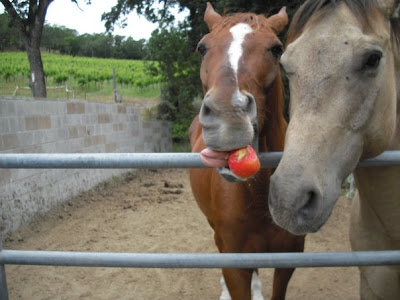

I don't care how many quotes I read about how much happier Lave Man is now than when residing in a paddock somewhere. No doubt a good horseman can read his animal's emotions to some degree; but until Lava Man inks the contract himself and tells us all just exactly what he really wants to do, this is just another case of humans putting themselves before the animals they claim to love.
Obviously the connections of Lava Man will say they'll only run the old guy if they're 100-percent sure he's healthy and capable. And the truth of the matter is they will have no clue. Consult the spirits of Barbaro, Eight Belles, Pine Island, George Washington and Ruffian.
Since the official announcement of Lava Man's return to the race track I have received numerous emails, phone calls, text messages, commentaries, comments and now the latest, a petition to remove Lava Man from the race track altogether. For some reason, this request directed to the California Horse Racing Board (CHRB), Dr. Rick Arthur and Doug O'Neill has irritated me more than the others. There isn't a horse alive that "inks a contract" so the comment is hyperbolic at best.
I understand the emotion, I understand the fear and I understand the risk for any horse on any given day; including the risk associated with the "un-retirement" of Lava Man. What I believe has been missed in most of the debate is the potential that many race horses will have their careers extended with the advances of stem cell procedures such as Lava Man's.
I am in a unique position, having a small glimpse into Lava Man from my association with some of those involved with him. I can say that originally I was shocked when I learned that Lava Man was galloping and training at Magali Farms months ago. I love Lava Man as much as the next person, and have had the privilege of seeing him several times during his racing and resting periods. I know the care and condition that he was in before he left Magali and arrived at Hollywood Park. The pictures for this post are from my last visit with him four days after he arrived back at the race track. Does this look like a beaten down, broke down, unhappy horse? I beg to differ.
But his being happy is not what this commentary is about. This commentary is from another point of view. The stem cell research while expensive at this time could have far reaching ramifications for race horses. Much like Barbaro, Eight Belles, and Ruffian (the later having an equine hospital named in honor of her) their tragedies did make a difference, but AFTER their injury and demise. Lava Man is alive and well, and the research and results will be monitored and that means going back to the race track and entering in a race to really understand the full success or failure of this procedure. Absolutely there is risk involved with this, heart sick risk, but when I think of the numbers of horses that could race longer, retire sounder, or have a better quality of life because of advances in equine medicine when they can no longer race, I have to take notice. Others like myself, take in the broken down horses that can't race. At 2 or 3 years of age these horses become available to rescues/retirement facilities on a regular basis. What if these same horses were able to take advantage of replacement therapies as a viable option instead of being a disposable commodity?
In California while synthetic tracks have reduced somewhat the catastrophic injuries, it has been documented that the injuries now to race horses are of a different nature. More fractures and career ending injuries due to the new tracks. What if stem cell therapy was an answer to keeping horses racing longer? Thereby extending for a few more years their careers and alleviating the need to scramble to find them homes (meaning not dumping them when they can no longer race. The potential results, more race horses running, filling races, and keeping horsemen and owners in the game, which is what this sport currently needs especially in California. http://www.bloodhorse.com/horse-racing/articles/49797/stem-cell-research-potential-benefits
The TOC (Thoroughbred Owners of California) recently produced a video of the presentation given on stem cell research perhaps if we educate ourselves on exactly what Lava Man has had done to him, we can better see the advantages of this medical intervention and remove emotion and name calling.
Let's stop for one minute, remove the emotion and outrage from whatever perceived ills the owners of Lava Man have done by putting him in training and let's look to the science of this decision for the greater good of many others. Perhaps this will make it easier to see that Lava Man may have not "inked" this deal, but I do know one thing, Lava Man is a champion in more ways than one, and could have the legacy that makes him one of the greatest for the sport of racing.






























